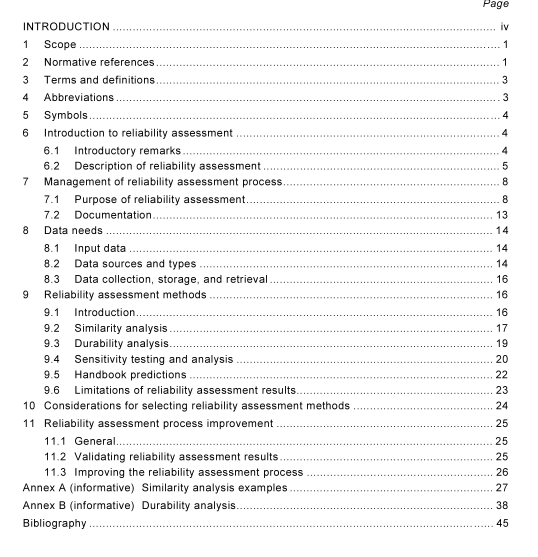AS IEC 62308 pdf – Equipment reliability—Reliability assessment methods

AS IEC 62308 pdf – Equipment reliability—Reliability assessment methods
6.2.4 Methods for estimating reliability The following is a list of methods commonly used for assessing reliability:
− similarity analysis;
− durability analysis;
− handbook methods.
The main benefit of a reliability assessment is the identification of the major contributions to system failure, rather than the accuracy of the absolute prediction. The identification of the sources of unreliability supports the prioritisation of actions and allows modifications to be made to the design at an early stage. This is especially important if components, modules or design solutions are reused from previous products. In this case the assessment method estimates the failure rate to be expected if improvement activities are not made. The accuracy of any prediction is determined by the quality of the data and their similarity to the proposed design and its usage and environment. Unless new technology is being considered, a reliability assessment should be based on appropriate in-service data that are available. Data may be obtained from a number of sources. In order of preference, they are as follows:
− the same or similar equipment used in the same or similar operational, physical and support environment;
− data derived from physical and engineering analysis across the range of environmental conditions in which it will be used;
− test data or field data from component or module suppliers;
− data from industry or generic sources.
Generic data sources need to be used with great caution and with lower confidence in the reliability assessment until such time as they can be replaced with better data. There are many generic and industry specific data sources to support reliability assessments. This standard describes a number of alternative reliability assessment methods that can provide failure rate data from an equipment level down to a functional or piece part level. When selecting a particular methodology for a specific application, a review of the accuracy and limitations of the approach to provide a justification for its usage should be documented. This justification should include the uncertainty and confidence factors associated with the results of the assessment method. This standard does not address software issues but only covers methods for hardware items. However, it can be used for hardware items that contain embedded software. Reliability of the embedded software and its interaction with the hardware must be addressed, which may change the original reliability information. 7 Management of reliability assessment process
7.1 Purpose of reliability assessment
7.1.1 General There are numerous reasons for assessing reliability of an item. Figure 1 illustrates some examples of the activities that require a reliability assessment as an input. For example, to calculate the spares provision for an item in the field, knowledge of the item’s failure rate and exposure time would be necessary.
A reliability assessment may be needed to fulfil the following tasks:
a) Reliability goal assessment – Reliability assessments are used to help assess the probability that the system can satisfy its reliability goals (feasibility study).
b) Comparisons of designs and products – Most systems have design implementation options. Tradeoffs have to be made among the various options, and reliability assessment is an important input to these tradeoffs. These options may even affect the system architecture, e.g. the amount and level of redundancy. Since tradeoffs often have to be made early in the design process, the reliability assessment may be very preliminary. However, it is still useful since the important information may be the relative reliability and ranking of design choices rather than a precise quantitative value.
c) Method to identify and prioritise potential reliability improvement opportunities – Reliability improvement activities should generally focus on the areas with the greatest opportunity for improvement. A reliability assessment quantifies the opportunity by identifying the relative reliability of various units and by predicting the reliability improvement obtained from a reliability improvement activity.









